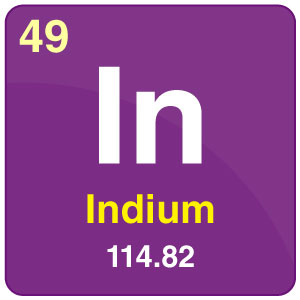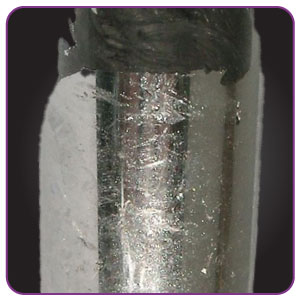Indium

| Symbol | In |
| Atomic Number | 49 |
| Atomic Mass | 114.82 g.mol-1 |
| Discovered by | Ferdinand Reich 1863 |

Chemical Properties of Indium
| Group | 13 | Melting point | 156.60°C,313.88°F,429.75 K |
| Period | 5 | Boiling point | 2027°C, 3681°F, 2300 K |
| Block | p | Density (g cm−3) | 7.31 |
| Atomic number | 49 | Relative atomic mass | 114.818 |
| State at 20°C | Solid | Key isotopes | 115In, |
| Electron configuration | [Kr] 4d105s25p1 | CAS number | 7440-74-6 |
| ChemSpider ID | 4514408 | ChemSpider is a free chemical database | |
What is Indium?
- Indium is a very soft, malleable, ductile and post-transition material. It is a silver colored element with tetragonal structure centered in the face. Indium will be in a liquid state over a variety of temperatures, like gallium from the same group. Both the metals, Indium, and Gallium are able to wet the glass i.e sticks to the surface of the glass in contact. These are stable when reacted with air and water but they dissolve in acids. If heated above its melting point it turns into a flame with violet color.
- Indium is not easily found or available in the environment. Cultivated lands posses more Indium than noncultivated lands.
Applications of Indium
- Used in the manufacturing of automobile bearings, which improves anti-seizure properties and moisture resistance.
- Used in semiconductor industries in the manufacturing of transistors, rectifiers, and diodes.
- Used in plating applications.
- Used in manufacturing of corrosive resistant mirrors.
Frequently Asked Questions – FAQs
Q1
Write the electronic configuration of Indium.
The electronic configuration of Indium is [Kr] 4d105s25p1 and its atomic number is 49.
Q2
Why Indium is called a p-block element?
The electronic configuration of Indium is [Kr] 4d105s25p1 and the last electron of Indium enters the p subshell. so it is called a p-block element.
Q3
What are the properties of Indium?
The atomic mass of Indium is 114.82 g/mol, its melting point is 156.60°C and its density is 7.31 grams per cubic centimetre.
Q4
What are the uses of Indium?
It is used in plating applications and in the manufacturing of corrosive resistant mirrors.


Comments